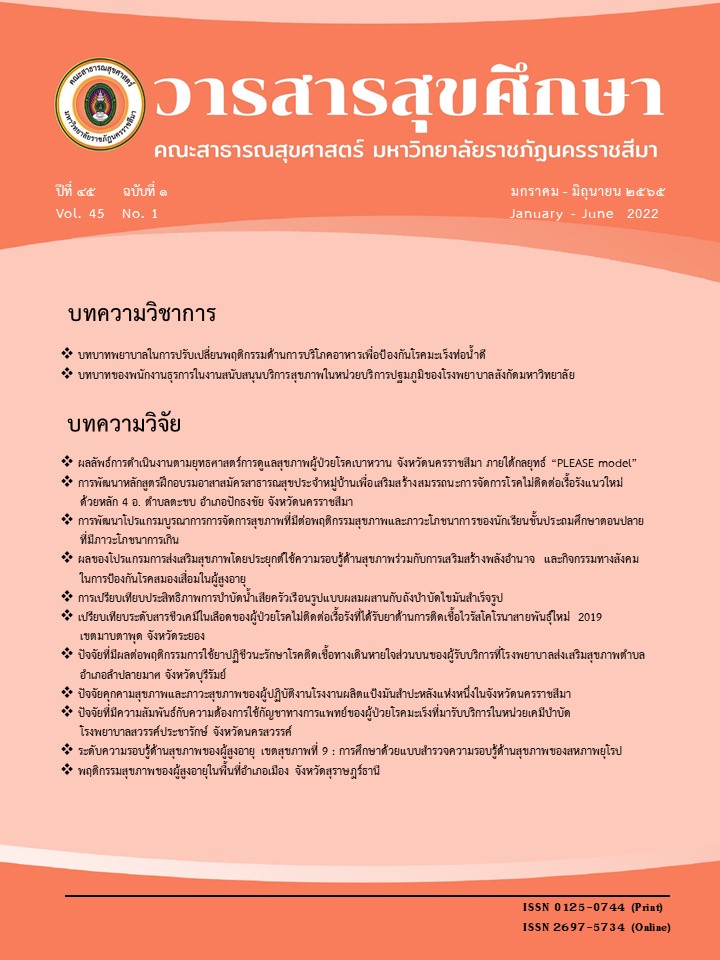Comparison of Efficiency on Combined Household Wastewater Treatment Process with Oil and Grease Trap การเปรียบเทียบประสิทธิภาพการบำบัดน้ำเสียครัวเรือนรูปแบบผสมผสานกับถังบำบัดไขมันสำเร็จรูป
Main Article Content
Abstract
Household wastewater from cooking was a serious problem. If there was no good wastewater treatment system before discharge into the water source or environment, it can affect the quality of water, bad smelling, spreading infection and disease-carrying animals and impact on human health. The objective of this study was to determine the comparison of efficiency on combined household wastewater treatment process with oil and grease traps. The sample of wastewater was untreated household cooking wastewater in Mueang, Surat Thani Province by the method of grab sampling. This research was divided into 2 experimental; Experimental 1 combined household wastewater treatment process, Experimental 2 was oil and grease trap. Both wastewater treatment tank had the capacity 30 liters and take a period of 7 days. Removal efficiency was analyzed from the water quality before and after treatment.
The results showed that the removal efficiency of Experimental 1 as increased neutral pH , BOD, suspended solid, total nitrogen, total phosphorus, fat oil and grease were 56.58%, 69.27%, 66.91%, 86.76% and 84.14%, respectively. Experimental 2 as slightly increased pH, BOD, total nitrogen, total phosphorus, fat oil and grease were 28.60%, 10.94%, 30.94%, 53.68% and 72.21%, respectively. Both types of tanks were passed the standards. Except for fat, oil and grease was still higher than the standards. It can be seen that combined household wastewater treatment process by using grease trap, electrolysis, bio-filters and water lettuce (Pistia stratiotes L.) had better removal efficiency than oil and grease trap. Therefore, it can be used as a guideline for developing a wastewater treatment system with integrated technology and should be increase the efficiency of oil and grease treatment to pass the standards.
Article Details

This work is licensed under a Creative Commons Attribution-NonCommercial-NoDerivatives 4.0 International License.
References
สำนักจัดการคุณภาพน้ำ กรมควบคุมมลพิษ กระทรวงทรัพยากรธรรมชาติและสิ่งแวดล้อม. คู่มือการจัดการน้ำเสียสำหรับบ้านเรือน [อินเทอร์เน็ต]. [เข้าถึงเมื่อ 25 เมษายน 2565]. เข้าถึงได้จาก: http://infofile.pcd.go.th/water/water_Manual_2555. pdf?CFID=21555452&CFTOKEN=56817448.
Krajangmek C, Nobnorb N, Hongkul R. A study on efficiency of conductive material for wastewater treatment from household by electrolysis process. In Dehasen University Bengkulu. Proceedings of 3rd International Conference on Health Science (ICH) 2018; 46–51.
รัตนาภรณ์ จันทค่อม, วรวัฒน์ น้อยหมื่นไวย และเพชร เพ็งชัย. ความเป็นไปได้ในการผลิตกระแสไฟฟ้าจากการบำบัดน้ำเสียด้วยระบบบึงประดิษฐ์โดยใช้ต้นกกราชินีเป็นพืชบำบัด. วารสารวิทยาศาสตร์และเทคโนโลยี มหาวิทยาลัยมหาสารคาม 2559; ฉบับพิเศษ: 98-103.
กรมควบคุมมลพิษ. มาตรฐานคุณภาพน้ำผิวดิน [อินเทอร์เน็ต]. [เข้าถึงเมื่อ 10 สิงหาคม 2562]. เข้าถึงได้จาก: http://pcd.go.th/info_serv/reg_std_water05.html#s3.
Olette R, Couderchet M, Biagianti S, and Eullaffroy P. Toxicity and removal of pesticides by selected aquatic plant. Chemosphere 2007; 70: 1414-1421.
กรมควบคุมมลพิษ. มาตรฐานควบคุมการระบายน้ำทิ้งจากระบบบำบัดน้ำเสียชุมชน [อินเทอร์เน็ต]. [เข้าถึงเมื่อ 27 พฤศจิกายน 2562]. เข้าถึงได้จาก: http://www.oic.go.th/FILEWEB/CABINFOCENTER3/DRAWER056/GENERAL/DAT A0000/00000 973.PDF.
ศศิพันธุ์ ณ สงขลา และคณะ. การวิเคราะห์ธาตุในเปลือกหอยโดยวิธีนิวเคลียร์. การประชุมวิชาการวิทยาศาสตร์และเทคโนโลยีนิวเคลียร์ ครั้งที่ 7 มหาวิทยาลัยเกษตรศาสตร์ 2541; 581-589.
Liu Y, Yang TO X, Yuan D.X, Wu X.Y. Study of municipal wastewater treatment with oyster shell as biological aerated filter medium. Desalination 2010; 254: 149-153.
เพ็ญศรี ศรีกิตติชัยกุล. ประสิทธิภาพของตัวกลางเปลือกหอยนางรมในการบำบัดน้ำเสียที่มีฤทธิ์เป็นกรดด้วยถังกรองไร้อากาศ. [วิทยานิพนธ์ปริญญาวิศวกรรมศาสตรมหาบัณฑิต สาขาวิชาวิศวกรรมสิ่งแวดล้อม]. กรุงเทพฯ: บัณฑิตวิทยาลัย จุฬาลงกรณ์มหาวิทยาลัย, 2552.
ปริญญา ไกรวุฒินันท์ และอัจฉรา โลราช. ประสิทธิภาพวัสดุตัวกลางในการบำบัดน้ำเสียระบบโปรยกรอง. วารสารวิทยาศาสตร์ มข. 2558; 43 (2): 260-266.
วิภารัตน์ ชัยเพชร. ขนาดของเปลือกหอยที่เหมาะสมในประสิทธิภาพการบำบัดไนโตรเจน และฟอสฟอรัส ในน้ำทิ้งบ่อกุ้ง. การประชุมวิชาการระดับชาติ ราชภัฎสุราษฎร์ธานีวิจัย ครั้งที่ 9 “การวิจัยเพื่อพัฒนาท้องถิ่นสู่ประชาคมอาเซียน” [อินเทอร์เน็ต]. 2562 [เข้าถึงเมื่อ 10 สิงหาคม 2562]. เข้าถึงได้จาก: https://sci.sru.ac.th/size-of-the-shells-optimal-in-efficiency-of-total-kjeldahl-nitrogen.
สนอง ทองปาน และชาติชาย ชาติตระกูล. การศึกษาประสิทธิภาพของถังบำบัดน้ำเสีย โดยกระบวนการอิเล็กโตรลิซิส. วารสารวิชาการศึกษาศาสตร์ 2550; 8 (1): 55-64.
ณัฐพล กสิวัฒน์. การบำบัดน้ำเสียไบโอดีเซลโดยการรวมตะกอนด้วยไฟฟ้าที่มีการเรียงขั้วไฟฟ้าแบบโมโนโพลาร์หลายเซลล์. [วิทยานิพนธ์ปริญญาวิศวกรรมศาสตรมหาบัณฑิต สาขาวิชาวิศวกรรมสิ่งแวดล้อม] กรุงเทพฯ: บัณฑิตวิทยาลัย จุฬาลงกรณ์มหาวิทยาลัย, 2552.
Priya M.,Jeyanthi J. Removal of COD, oil and grease from automobile wash water effluent using electrocoagulation technique. Microchemical Journal 2019; 150: 104070.ฐปน ชื่นบาล, วันทมาส จันทะสินธุ์ และศิราภรณ์ชื่นบาล. การบำบัดน้ำเสียฟาร์มสุกรและคุณค่าทางโภชนะของจอก (Pistia stratiotes L.).วารสารวิทยาศาสตร์และเทคโนโลยีแห่งรัตนโกสินทร์ 2021; 3(2): 19-27.
ฐปน ชื่นบาล, วันทมาส จันทะสินธุ์ และศิราภรณ์ชื่นบาล. การบำบัดน้ำเสียฟาร์มสุกรและคุณค่าทางโภชนะของจอก (Pistia stratiotes L.).วารสารวิทยาศาสตร์และเทคโนโลยีแห่งรัตนโกสินทร์ 2021; 3(2): 19-27.


